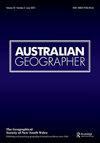Critical minerals: rethinking extractivism?
IF 2
2区 社会学
Q2 GEOGRAPHY
引用次数: 2
Abstract
ABSTRACT Acceleration in political support for critical minerals industry development is linked to securing resource supply chains essential to low carbon futures. This commentary reviews the Australian critical minerals agenda, scrutinising urgency claims engulfing the ‘rush’ to extract critical minerals. First, we define critical minerals and examine their ‘criticality’ in relation to decarbonisation and geopolitical motivations. The idea that the emergent industry is premised on an ethics of climate action conflicts with evidence that reputational risk and market shifts are driving companies. Second, we problematise urgency claims, arguing that crisis narratives and regulatory fast-tracking mask serious socio-environmental justice concerns, while neglecting material blockages. We distinguish the production of materials central to low carbon futures from localised social and environmental impacts of their extraction and processing, raising concerns over the absolution work performed by urgency claims. The burgeoning critical minerals industry presents an epochal moment to reconstitute mining differently to meet socio-environmental justice goals. Instead, as currently imagined, it extends a frontier mentality and existing models of extractivism, reproducing colonial-capitalist legacies. We conclude by advocating for counter-urgencies that foreground materiality and view critical minerals as policy commons, enabling debates on the shape of the critical minerals industry before it is fully established.关键矿物:重新思考开采主义?
摘要:加快对关键矿产行业发展的政治支持,与确保低碳期货所必需的资源供应链有关。这篇评论回顾了澳大利亚的关键矿产议程,仔细审查了吞噬关键矿产开采“热潮”的紧急声明。首先,我们定义了关键矿物,并研究了它们与脱碳和地缘政治动机之间的“关键性”。新兴行业以气候行动伦理为前提的观点与声誉风险和市场变化正在推动公司发展的证据相冲突。其次,我们对紧迫性主张提出质疑,认为危机叙事和监管快速追踪掩盖了严重的社会环境正义问题,而忽视了物质障碍。我们将低碳期货的核心材料生产与其提取和加工的局部社会和环境影响区分开来,这引发了人们对紧急索赔所做的赦免工作的担忧。新兴的关键矿产行业为以不同方式重建采矿业以实现社会环境正义目标提供了一个划时代的时刻。相反,正如目前想象的那样,它扩展了一种前沿心态和现有的榨取主义模式,再现了殖民资本主义的遗产。最后,我们主张采取反紧急措施,突出重要性,并将关键矿产视为政策公地,从而在关键矿产行业完全建立之前,就其形态展开辩论。
本文章由计算机程序翻译,如有差异,请以英文原文为准。
求助全文
约1分钟内获得全文
求助全文
来源期刊

Australian Geographer
GEOGRAPHY-
CiteScore
4.10
自引率
8.30%
发文量
33
期刊介绍:
Australian Geographer was founded in 1928 and is the nation"s oldest geographical journal. It is a high standard, refereed general geography journal covering all aspects of the discipline, both human and physical. While papers concerning any aspect of geography are considered for publication, the journal focuses primarily on two areas of research: •Australia and its world region, including developments, issues and policies in Australia, the western Pacific, the Indian Ocean, Asia and Antarctica. •Environmental studies, particularly the biophysical environment and human interaction with it.
 求助内容:
求助内容: 应助结果提醒方式:
应助结果提醒方式:


